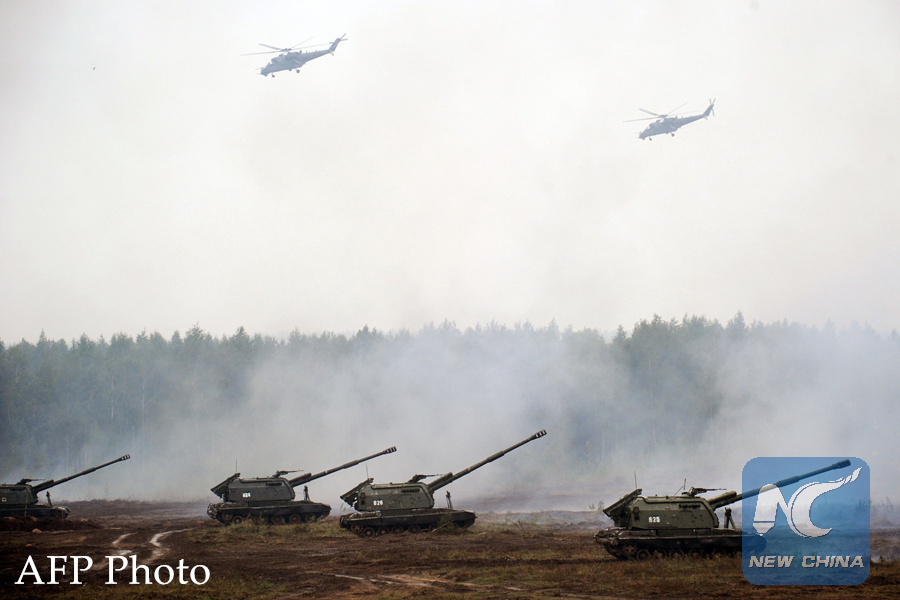
Helicopters and military vehicles take part in the joint Russian-Belarusian military exercises Zapad-2017 (West-2017) at a training ground near the town of Borisov on September 20, 2017. (AFP PHOTO)
by Liao Bingqing
MOSCOW, Sept. 22 (Xinhua) -- The week-long Russia-Belarus joint military drills Zapad-2017 (West-2017) ended Wednesday, and yet anxious speculations around them from western countries are still continuing to hover.
Despite Moscow's repeated claim of the defensive character of the drills, tensions are expected to be further exacerbated between Russia and the West.
Russia's European neighbors have been on high alert since the beginning of the drills. Skeptical about the "real intentions" of Moscow, members of the North Atlantic Treaty Organization (NATO) criticized a lack of transparency in the drills.
"All nations have the right to exercise military forces ... The important thing is that when forces are exercised there is maximum transparency and predictability to avoid miscalculations, misunderstandings and incidents," NATO Secretary General Jens Stoltenberg said Thursday.
In response, the Russian side, stressing that the exercises were solely defensive in nature, refuted the allegation and slapped it back for stirring up irrational sentiments, which, as the Kremlin noted, could only be perceived as "provocation."
The Zapad-2017 drills, reportedly the largest in scale between Russia and Belarus since the Cold War, involved up to 12,700 troops, 70 helicopters, 680 combat vehicles and 10 warships. More than 90 foreign representatives from over 50 countries have come to observe the exercises, according to the Russian Defense Ministry.
"The configuration of the forces involved, the goals and objectives set before the exercises prove unequivocally their defensive nature," said Igor Korotchenko, editor-in-chief of Russia's National Defense magazine.
In view of a bigger picture, Moscow may not intend to irritate NATO or even risk a military confrontation with it, but that does not stand in the way of showing its muscles, analysts said.
By demonstrating capabilities of its modernized military forces, Russia sent out a clear message to NATO countries warning of what they will be faced with if they make an impulsive move, they noted.
It did not make much efforts to disguise this purpose. Three fictional countries were created as the combat targets during the Zapad-2017 drills, namely Veishnoria, Vesbaria, and Lubenia, which shared a lot in common with Latvia, Lithuania, and Poland, the NATO members on the border of Russia and Belarus.
And this comes even more conveniently at a time when tensions between Russia and the West have already soared to the highest level in decades.
Hostility between the two sides has been on the rise since the start of the Ukrainian crisis in 2014, and things have worsened even sharply of late following the approval of a new U.S. sanction bill on Russia in July. With Moscow and Washington trading accusations and escalating sanctions for the past two months, worries are flying that a second Cold War is coming.
In the meantime, NATO is building up its military presence in the three Baltic states and Poland while frequently approaching the border area of Belarus.
"Russia and Belarus are consistent in their general interests. Russia is currently having a hard time with the West, while relations between Belarus and the West have always been tense ... By means of the military drills, the two countries intended to enhance their military cooperation and warn against further aggression from the West," said Yang Mian, a professor at the Institute of International Relations of the Communication University of China.
However, military moves of Russia and the West now seem to have worked up into a competition. According to latest reports, NATO itself is conducting naval exercises in Turkish waters in the Mediterranean Sea and has also launched major defensive drills in northern Poland amid disputes around the Zapad-2017 drills. Given the circumstances, there is little chance to break the vicious cycle anytime soon.
"The world today is unstable. The increase in geopolitical risks makes different countries pay more attention to the issues of their military security. The increased number of military exercises in different countries of the world just reflects this fact," Korotchenko said.
Despite the spiral of military exercises, analysts said there is no threat of open conflict.
While noting the certainty of stronger defense from NATO, Yang Mian said that the military alliance will not let the situation descend into catastrophic hostility, for it is "well aware of the root causes of how things have developed into the current situation."
"The bottom line is that nobody is going to go to war with each other," said Alexander Titov, a professor at Queen's University in Belfast, Northern Ireland, "because the costs are too high after all the froth is taken out of the debates."
On the other hand, increasingly frequent demonstration of military powers further dims the hope for mending ties between Russia and Western countries, analysts said.
"In the context of such large-scale military exercises ... mutual mistrust and hostility will certainly be further strengthened ... The two sides will not stop contacts across the board, but their relationship is deteriorating in essence," Yang Mian said.

